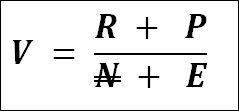 What are your products and services actually worth to customers? Not many organizations are able to answer this question, but it’s very important.
What are your products and services actually worth to customers? Not many organizations are able to answer this question, but it’s very important.
In fact, right now, with so many things changing in the way we live, the ability to understand the value of our product or service from the customer’s perspective has never been more important. And that’s where the value equation helps.
Value means the benefit the customer gets from our product or service compared to its cost to them. Put differently, it means benefit to cost ratio.

That’s why, in order to increase value for our customers, we increase the benefit they get and/or reduce what it costs them to acquire the product or service. But we all know that cost is not just monetary and benefit is not just the outcome or the tangible product.
Hence, the definition of value is expanded further which results to the value equation shown below.

The Value Equation
Though not usually stated, value equation exists for every organization. But having it well stated and understood makes it a vital tool for making key strategic decisions. Thus a brief explanation of the value equation is shown below.
R – Result
This is the primary result or need of the customer. If a customer wants to go to Abuja from Lagos, it’s just travel from A to B. Nothing more, nothing less. If a customer who wants to buy a pair of shoes enters a boutique, did he buy one?
P – Process
The customer can achieve the primary result in many ways. The difference is the way they do it. In the Value Equation, we call this the Process.
Getting from Abuja to Lagos can be by chartered taxi, by private car, by public bus, by air (economy class), or by flying business class. Buying a pair shoes can be by going to a boutique, by going the open market, or by shopping online and having it delivered to the customers at home.
It’s important to analyze our processes in terms of what creates value for the customer because it almost always increases the expenses. For instance, the low cost airline concept aims at minimizing the processes of getting from A to B, leaving the customer with almost nothing but the primary result.
Some of the elements you can find under processes include time (speed), competence, reliability, and friendliness
₦ – Price
Price is, of course, what the customer has to pay for the product or service in monetary terms.
E – Effort
Effort is to which degree the customer makes an effort, him or herself, in getting the primary result.
While going from Abuja to Lagos, if the customer uses a public bus instead of taking a flight, they make a great effort themselves – when they sit in the bus, wait for it be filled, and stay hours before arriving at Lagos. Similarly, if the customer, instead of shopping online, goes to an open market to buy a pair of shoes , they make great effort.
When customers make great effort, monetary price is reduced for them so as to sustain value – the effort reduces the price.
Generally, as shown, the value equation has four variables – Result, Process, Price, and Effort. And to increase value for the customer, organizations can adjust any of the four variables. This is both practically and mathematically correct.
For instance, if you reduce monetary cost(₦) for your customers, value(V) increases. On the other hand, if the customer is made to make great effort(E) to get your product or service, value decreases. Also, value increases if the result(R) is significant or if the elements of the process(P) are favourable.
All services or products are as a result of unique combinations of the four variables. Different organizations work with their own combinations with the most clever organizations having several value equations operating at the same time – one for each segment of their customers and different situations.
The value equation helps you to understand what customers need. This is critical because the obvious consequence of not understanding the needs of the customer is that they might never return.
So what is your organization’s value equation? As the novel corona virus changes the way we currently live with the attendant economic implications, what will your organization’s new value equation be?
How has your customer’s primary need (R) changed? Is your process (P) in line with the emerging rules of social distancing and hygiene that keep your customers safe? What about the effort (E) your customer must to make to get their primary needs met? Is it favourable in the present circumstance or will it expose them to more risk? What price (₦) will be ideal in the present economic realities to ensure your customers still get significant value(V)? And more…
At anytime, it’s important for every organization to have an accurate understanding of what its customers value, and would value. You may want to review your organization’s value equation(s) today.